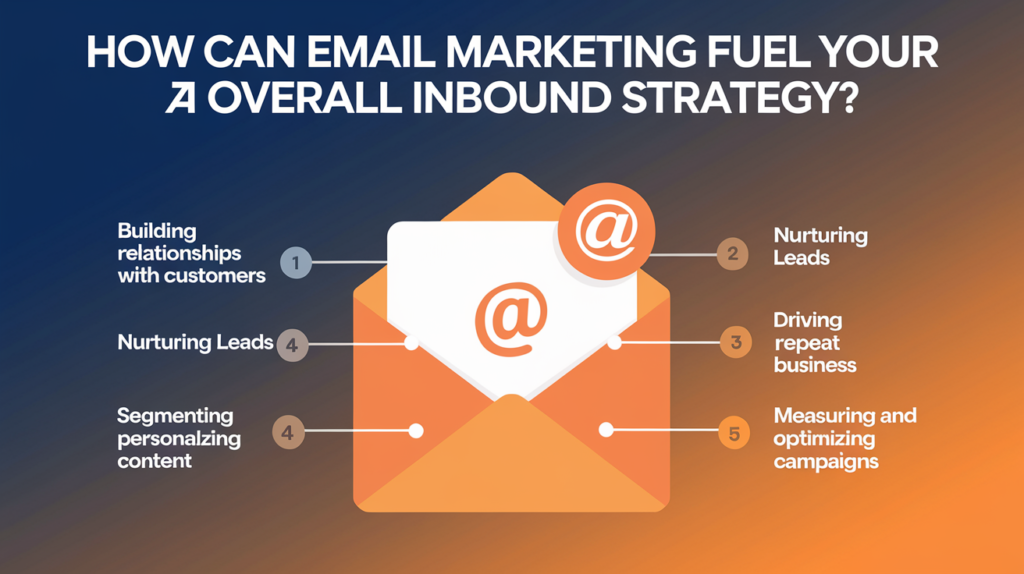Email marketing can boost your inbound strategy significantly. It engages your audience and drives traffic.
In today’s digital world, email marketing is a powerful tool. It’s not just about sending messages; it’s about building relationships. When done right, email marketing can attract, engage, and delight your audience. It integrates smoothly with other inbound marketing tactics.
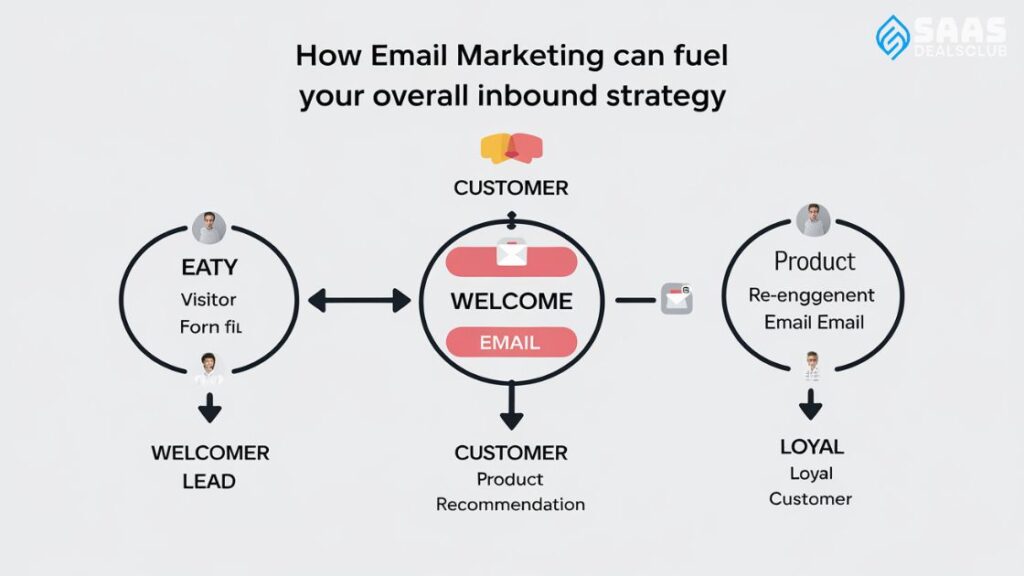
With the right approach, email marketing can nurture leads and convert them into loyal customers. This blog will explore how email marketing can enhance your overall inbound strategy, offering valuable insights and practical tips. Stay tuned to discover the secrets of leveraging email marketing for maximum impact.
Table of Contents
ToggleIntroduction To Email Marketing
Email marketing is a powerful tool. It helps businesses communicate directly with their audience. By sending targeted emails, companies can engage customers effectively. This method is cost-efficient and measurable. Additionally, it integrates well with other marketing strategies.
Purpose And Benefits
Email marketing serves several purposes. Here are some key benefits:
- Builds Relationships: Regular emails keep customers informed and engaged.
- Boosts Sales: Targeted campaigns can drive more sales.
- Increases Website Traffic: Emails can direct readers to your website.
- Cost-Effective: Compared to other marketing channels, it is affordable.
Emails also allow for personalization. Personalized content can increase engagement rates. This makes email marketing an essential part of any inbound strategy.
Evolution Of Email Marketing
Email marketing has evolved significantly. Initially, emails were generic and often spammy. Today, the focus is on delivering value. Modern email marketing uses data and automation. This helps in creating personalized and relevant content.
Here are some key milestones in email marketing:
| Year | Milestone |
|---|---|
| 1978 | The first marketing email sent. |
| 1991 | Introduction of the Internet to the public |
| 2003 | CAN-SPAM Act passed |
| 2008 | Rise of mobile email usage |
| 2014 | Introduction of GDPR |
These milestones show the growth and refinement of email marketing. Today, it is more sophisticated and user-friendly. This makes it an essential tool for inbound strategies.
Building An Email List
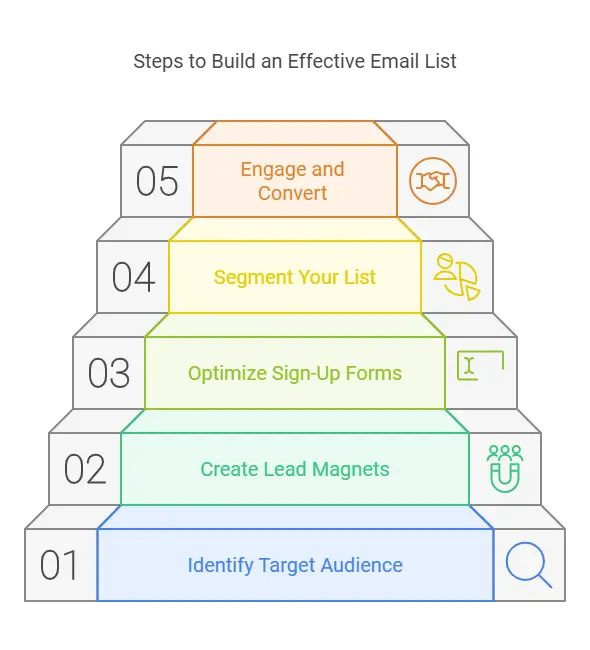
Building an email list is crucial for a successful email marketing campaign. A strong list ensures your messages reach the right audience. This increases the chances of engagement and conversions. Below, we explore effective ways to build your email list.
Opt-in Strategies
Opt-in strategies are methods to encourage users to subscribe to your email list. These strategies must be ethical and non-intrusive. Here are some effective opt-in strategies:
- Pop-up Forms: Display pop-up forms on your website to capture visitor information. Ensure the forms are easy to close if the user is not interested.
- Lead Magnets: Offer valuable content like eBooks, whitepapers, or discounts in exchange for email addresses.
- Sign-up Forms: Place sign-up forms in visible areas on your website, such as the header, footer, or sidebar.
- Social Media: Promote your email list on social media platforms to attract subscribers.
Segmentation Techniques
Segmentation techniques involve dividing your email list into smaller groups. This ensures more personalized and relevant content for each subscriber. Here are some effective segmentation techniques:
- Demographic Segmentation: Segment your list based on age, gender, location, or income.
- Behavioral Segmentation: Use past purchase behavior, email engagement, or website activity to segment your list.
- Interest-based Segmentation: Group subscribers based on their interests or preferences.
- Lifecycle Stage Segmentation: Segment based on where the subscriber is in the customer journey.
Using these strategies and techniques will help you build a strong, engaged email list. This is key to a successful email marketing campaign.
Crafting Compelling Content
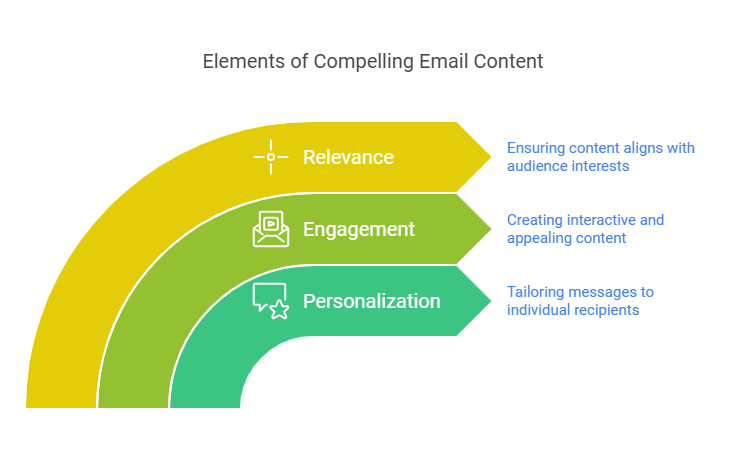
Email marketing plays a crucial role in your overall inbound strategy. One of the key elements to ensure its success is crafting compelling content. This involves creating personalized, engaging, and relevant messages that resonate with your audience.
Here, we will focus on two essential aspects: Personalization Tips and Engaging Subject Lines.
Personalization Tips
Personalization can greatly enhance the effectiveness of your email campaigns. Tailoring your content to each recipient’s preferences and behavior can increase engagement and build trust.
- Use recipient’s name: Start with a friendly greeting that includes the recipient’s name.
- Segment your audience: Group your audience based on demographics, interests, and behavior.
- Send relevant content: Ensure the content matches the recipient’s past interactions with your brand.
- Include dynamic content: Use dynamic fields to display personalized product recommendations.
Engaging Subject Lines
The subject line is the first thing your audience sees. It can determine whether they open your email or not. Crafting engaging subject lines can significantly impact your open rates.
| Tip | Explanation |
|---|---|
| Keep it short: | Use 50 characters or fewer. Make it easy to read at a glance. |
| Create curiosity: | Ask a question or tease content to intrigue the reader. |
| Use action words: | Encourage the reader to take action with strong verbs. |
| Include numbers: | Numbers can make your subject line more specific and compelling. |
| A/B testing: | Test different subject lines to see which one performs better. |
By focusing on personalization and creating engaging subject lines, you can enhance your email marketing efforts. This will help in nurturing leads and driving conversions.
Automation And Workflows
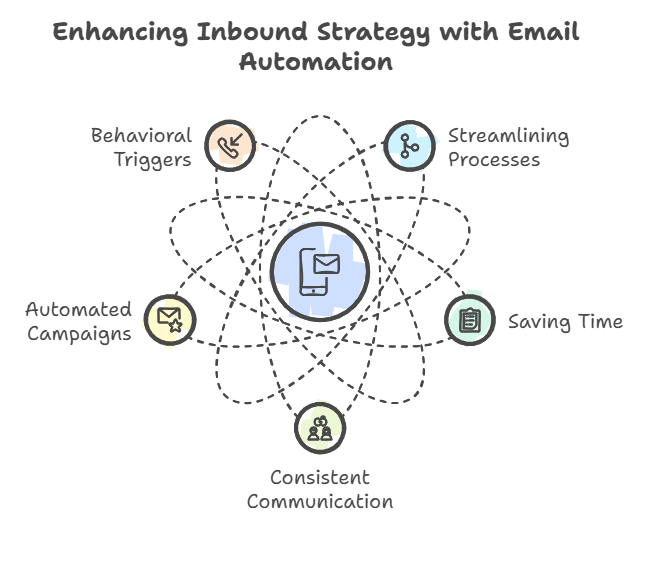
Email marketing automation and workflows play a crucial role in enhancing your inbound strategy. They help streamline processes, save time, and ensure consistent communication with your audience. By setting up automated campaigns and behavioral triggers, you can engage your subscribers more effectively.
Automated Campaigns
Automated campaigns allow you to send emails based on specific actions or timelines. This ensures that your subscribers receive relevant content at the right time.
You can set up welcome emails for new subscribers, follow-up emails after purchases, or reminders for abandoned carts. These automated messages keep your audience engaged without requiring manual effort.
Behavioral Triggers
Behavioral triggers send emails based on user interactions and behavior. This includes actions like opening an email, clicking a link, or visiting a specific page on your website. By tracking these behaviors, you can send personalized emails that resonate with your audience.
For example, if a subscriber clicks on a product link, you can send a follow-up email with more information about that product. This approach helps create a more personalized experience for your subscribers.
Analyzing Performance
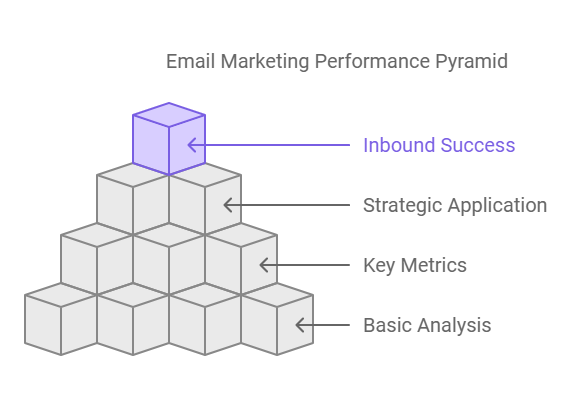
Analyzing performance in email marketing is essential. It helps you understand what works and what does not. Without proper analysis, you are flying blind. This makes it hard to improve your campaigns.
By focusing on key metrics and strategies, you can enhance your inbound strategy. Let’s dive into some important aspects.
Key Metrics To Track
Tracking key metrics is crucial. Open rates show how many people open your emails. High open rates mean your subject lines are effective. Click-through rates (CTR) measure engagement. They indicate how many recipients click on links within the email. Conversion rates tell you how many people took the desired action. This could be making a purchase or signing up for a webinar.
Bounce rates indicate email delivery success. A high bounce rate means many emails did not reach inboxes. Keep an eye on unsubscribe rates. They show how many people opt out of your email list. High unsubscribe rates may mean your content is not relevant.
A/b Testing Strategies
A/B testing helps you find what works best. It involves sending two versions of an email to different groups. Then, compare the results to see which version performs better. Test subject lines first. They are the first thing recipients see. Try different lengths and tones.
Next, test email content. Experiment with different layouts and messages. See which one gets more engagement.
Also, test call-to-action (CTA) buttons. Different colors and wording can have a big impact. Use A/B testing to optimize send times. Different times of day can lead to different open rates. Regular testing and analysis lead to better results.
Integrating With Other Channels
Integrating email marketing with other channels can enhance your inbound strategy. It creates a cohesive experience for your audience. Email marketing works well with social media and content marketing. Let’s dive into how these integrations can benefit your business.
Social Media Synergy
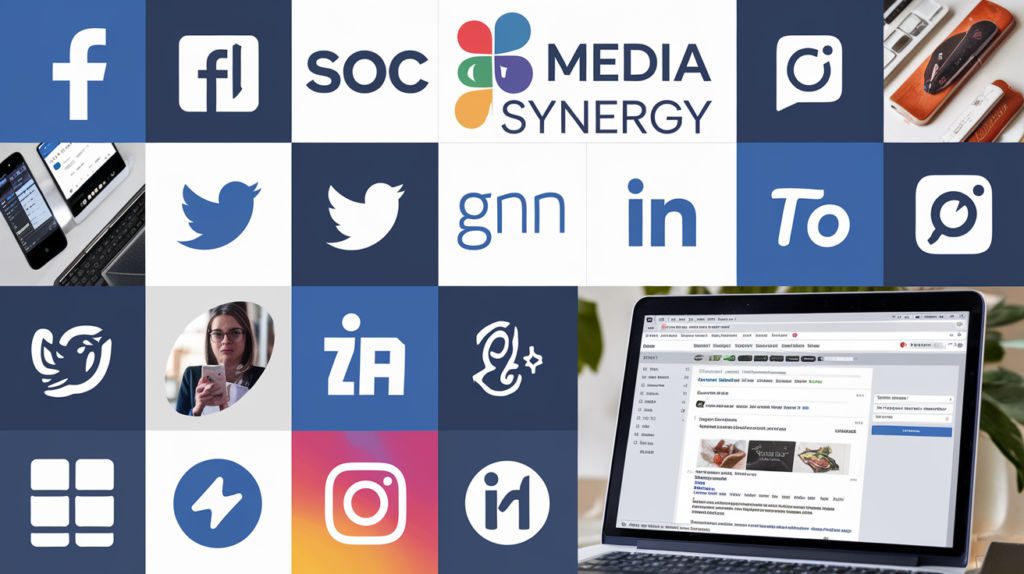
Email marketing and social media can work together. Share your email content on social media platforms. This helps you reach a wider audience. Encourage your social media followers to join your email list.
Offer exclusive deals or content to your email subscribers. This integration keeps your audience engaged across channels.
Content Marketing Alignment
Email marketing can support your content marketing efforts. Share blog posts, videos, and other content through your emails. This drives traffic to your website. Use email to promote new content and engage your audience.
Create segmented email lists based on content preferences. This ensures your audience receives relevant content.
Compliance And Best Practices
Email marketing can drive your inbound strategy. It requires adherence to compliance and best practices. Understanding these guidelines ensures your campaigns run smoothly.
They also protect your brand’s reputation. Let’s explore key aspects of compliance and best practices.
Gdpr Considerations
The General Data Protection Regulation (GDPR) affects businesses targeting EU citizens. Ensure clear consent from subscribers before sending emails. Use simple language in your consent forms. Provide an easy opt-out option in every email. Maintain records of consent for compliance purposes. Data protection is crucial under GDPR.
Can-spam Guidelines
The CAN-SPAM Act protects U.S. email recipients. Include a clear sender identity in your emails. Avoid misleading subject lines. Provide a visible and functional unsubscribe link.
Honor opt-out requests promptly. Your physical address should be in every email. Compliance with CAN-SPAM builds trust.
Future Trends In Email Marketing
Future trends in email marketing are reshaping how businesses connect with customers. With rapid advancements in technology, marketers can now create more personalized and engaging email campaigns. These trends not only enhance user experience but also drive better results.
AI and Machine Learning
AI and machine learning are transforming email marketing. They help marketers analyze large amounts of data. With this, personalized email content becomes easier to create. Predictive analytics can determine the best time to send emails. This increases open rates and engagement.
AI can also help segment email lists more effectively. It groups subscribers based on behavior and preferences. This ensures that each recipient gets relevant content. Machine learning algorithms can even optimize subject lines. They increase the chances of your email being opened.
Interactive Emails
Interactive emails are a growing trend. They allow recipients to engage with content directly within the email. This reduces the need to click away to another site. Features like image carousels, surveys, and polls can be included. These elements make emails more engaging and fun.
Interactive emails can also include live content. This means that emails can be updated in real-time. For example, countdown timers can show the time left for a sale. Live social media feeds can display the latest posts. This keeps the content fresh and relevant.
Future trends in email marketing focus on enhancing user experience. AI, machine learning, and interactive elements are key to this. They make emails more personalized and engaging. As technology evolves, email marketing will continue to improve.
Frequently Asked Questions
What Is Email Marketing?
Email marketing involves sending promotional messages to a group of people via email. It’s used to build relationships, promote products, and drive conversions.
How Does Email Marketing Boost Inbound Strategy?
Email marketing nurtures leads by providing valuable content. It drives traffic to your website, increasing engagement and conversions.
Why Is Segmentation Important In Email Marketing?
Segmentation targets specific groups within your audience. This ensures relevant content, improving open rates and engagement.
How Can Email Marketing Increase Website Traffic?
Email marketing includes links to your website. This encourages recipients to visit, boosting site traffic and potential conversions.
Conclusion
Email marketing boosts your inbound strategy effectively. It nurtures leads and builds trust. Engage your audience with tailored content. Consistent email outreach drives conversions. It complements other marketing channels seamlessly. Use data to refine your approach. Embrace the power of email marketing now.
Enhance your inbound efforts with strategic emails. Your business growth depends on it.

